In recent years, it has become especially popular to keep decorative African hedgehogs that do not live in the wild at home. For this reason, they can not be released on a free range. Such a breed of hedgehogs was obtained by breeding several breeds, as a result of which the mammals were very hardy and at the same time adapted for life in an apartment or private house. Further, we will consider in more detail the description of such animals, learn everything about their life expectancy and maintenance, and also get acquainted with the features of caring for them and the rules of feeding.
Description
Dwarf African hedgehogs were bred by artificial breeding specifically for human maintenance. Such hedgehogs look very cute, they are not at all dangerous, weighing about 500 g, and in length - about 20 cm. They differ among themselves mainly in color. Unlike forest species, needles are softer, which is undoubtedly a big plus.
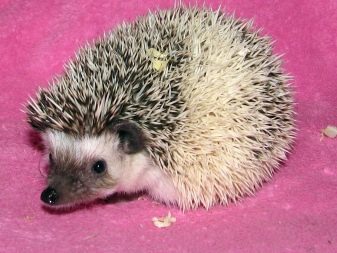

Dwarf hedgehogs are very friendly, quickly get used to living in a family. They do not hibernate, have no unpleasant pungent smell, and do not disturb their owners at night, because their lifestyle is completely different from wild individuals of this kind.
It is not necessary to keep animals as a couple, since they also feel great one at a time, the main thing is to surround the pet with care.


Let us consider in more detail their varieties by color.
- Dwarf gray individuals they have black eyes and a nose; on the belly and legs they may have dark spots. The needles are soft, dark gray or brown, usually on the back and in the ears they have a transitional color from gray to black.
- Brown individuals have lighter needles, eyes are dark, may have a dim edge, nose has a chocolate color. The skin is pale pink with a grayish tint.
- Chocolate pygmy hedgehogs needles of pronounced brown color, eyes are black, and nose is pale brown. Such individuals look especially attractive and cute. On the abdomen and legs, this species sometimes has characteristic dark spots.
- There is also a kind of "champagne", the color of the needles of such individuals is usually gray-brown or light beige, the nose is pink, the eyes may have a ruby color.
- There are also hedgehogs with a cinnamon colorthat have milky beige needles.
- When choosing a pet, we recommend that you pay attention to the common color “salt and pepper”. Hedgehogs are almost black, but less pigmented needles are present in the color. The skin on the ears and on the back of such individuals is usually dark.
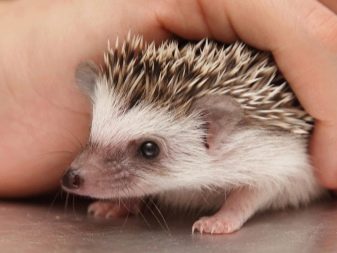



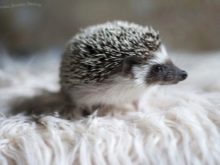
Often dwarf hedgehogs are born albinos, that is, they have completely white needles, a soft pink nose and brightly expressed scarlet eyes. And there are just white hedgehogs that are not albinos, their needles are almost all discolored.
Of course, breeders of dwarf hedgehogs often experiment, resulting in original and even unique colors.
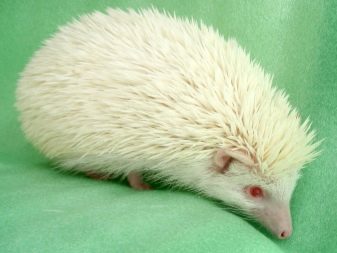

Life span
Before you make yourself a new "neighbor", it is very important to find out everything about him, including how many dwarf hedgehogs live. Of course, in the wild, hedgehogs have to fight for their existence, get their own food and look for places for wintering, this is impossible at home, as a result of which the life expectancy of individuals, of course, increases.
With proper and regular care, African hedgehogs can live a fairly long period, varying from 5 to 7 years, but there are cases when such pets lived for ten years.
The main thing in the content is to properly feed the pet and provide him with a comfortable place to live, as well as control his health, and consult a veterinarian as necessary.

Conditions for keeping
To make the life of a home African hedgehog comfortable, very little effort is required. Consider the most important points in the content.
- For the pet, you need to choose a spacious and comfortable cage. Often, the owners do it on their own, but it is best to take a ready-made version, in which there will not be too sharp rods. The animal may get hurt about them. Terrarium for the maintenance of the hedgehog is not suitable, like a regular box. The floor of the cage must be covered with an even coating.
- Sawdust can be used as litter in a cage, special filler or paper granules. As for sawdust, you should buy options not from resinous and coniferous trees, for hedgehogs they can be toxic. The best are birch sawdust. Sawdust is poured 1.5-2 cm onto the floor in the cage, as evenly as possible. Cage cleaning, including litter change, is usually done every 7 days, more often if necessary, especially if a couple of individuals live in the cage.
- Although decorative hedgehogs are domestic, they, like free individuals, should always have a place where they can hide. For these purposes, in the cage you can put a small house for the solitude of a hedgehog, in pet stores, experts recommend choosing the one that is sold for chinchillas, but such a house, in general, can be done independently.
- Dwarf hedgehogs are as active as domestic hamsters, therefore, if the animal is not allowed to freely run around the apartment or house, it is best to put a running wheel in the cage for it, the diameter of which should be about 30 cm. The wheel is also useful for hedgehogs in terms of health: many domestic animals are prone to obesity.
- Do not forget about the toilet, which is an important attribute in the life of an African hedgehog. Clean the toilet area daily.
- Cage-mounted drinker It must either be attached to it itself, or be very heavy so that the animal does not turn it over. Water is recommended to be changed every day.
- As toys for decorative hedgehogs bells, bells and various balls are perfect.
- It is recommended to keep hedgehogs at a temperature of 20 to 25 degrees. Overheating of the room, as well as its hypothermia, can lead to a disease of the pet. Moreover, if the temperature is less than 15 degrees, even a decorative hedgehog can hibernate, although this is not characteristic of him. It is also very important to prevent drafts in the place of residence of the hedgehog and not to open windows too often, especially when the weather is cool. Hedgehogs do not really like the sun, so you should not place the cage too close to the window with direct sunlight.



Feeding rules
Today, dwarf domestic hedgehogs are usually fed with ready-made food, but specialized food for hedgehogs in small cities is very difficult to get, which is why many people choose premium balanced cat food as their food. The main thing is to avoid the presence of starch, various dyes and flavors in the composition. When choosing food, it is best to get expert advice in advance.
We learn in more detail about the possible diet of domestic hedgehogs and about acceptable products that can be given to the animal.

Hedgehogs, in addition to ready-made food, can and should give other products.
- Boiled lean meat. Mostly turkey, chicken and beef. Before serving, it is recommended to cut the meat into small pieces.
- Raw or boiled chicken eggs can also be quail. Do not give more than 1-2 eggs per week.
- Boiled fillet of sea or river fish. If fish with bones is cooked, then it should be thoroughly cleaned before serving.
- Vegetables. You can give fresh or boiled carrots, as well as asparagus, cucumbers and broccoli.
- Fruits and berries. It is best to give apples, pears, bananas and melons in small slices. Exotics should be avoided and fruits and berries that are not known should be given. So, for example, a hedgehog can be poisoned by citrus fruits, which are contraindicated to it. Fruits can be replaced with baby puree, however, it should not contain starchy ingredients.
- Hedgehogs in the wild - Real predators, but also domestic predators sometimes do not mind eating grasshoppers and worms, which can be purchased at a pet store without any problems.
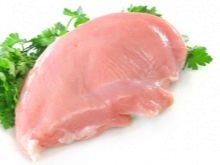


Also consider prohibited foods that can harm the health of the pet.
- Any dairy products. Contrary to popular belief that hedgehogs love milk, it is practically not absorbed by them, leading to various diseases. It is recommended to exclude any dairy and sour-milk products from the diet.
- Pineapples, avocados, oranges, tangerines and lemons, as well as any exotic fruits and berries of the lychee type.
- Dried fruits, raisins, grapes, nuts and seeds. Such products can cause suffocation of a domestic hedgehog.
- Sweets, including sweets and chocolates. Hedgehogs, like many other animals, are prone to diabetes, which is why such treats are best excluded.
- Salt, spices, seasonings and all products with them are strictly forbidden to decorative hedgehogs, like any wild ones. Onions, garlic and any fast food are also prohibited.



Care
Caring for a home hedgehog is easy. Care measures include selecting the right diet, bathing and controlling the appearance of parasites. You can also train domestic hedgehogs, which will help to perfectly organize their leisure.

African domestic hedgehogs can not only be washed, but also need to be done, some animals love this procedure very much, especially if they are accustomed to it from childhood, but many treat it extremely negatively. Hedgehogs are washed no more than 2 times a month, in the cold season as little as possible, since the needles dry for a very long time, and at this time the animal can catch a cold. Hedgehogs are bathed in a basin, pouring about five liters of water into it, the water temperature should not be more than 35 degrees.The needles can be cleaned with a special shampoo and a non-rigid toothbrush.
When bathing, it is very important to avoid getting water on the face. After bathing the hedgehog, it is recommended to wrap it in a towel, it should dry on its own.
African domestic hedgehogs are usually treated for various internal and external parasites, but they are not given any vaccinations, since today there are no specialized vaccines for decorative hedgehogs.
Wash bowls after meals regularly. To do this, it is best to use laundry soap. If the animal shows signs of the disease, then do not self-medicate, you should immediately contact a veterinarian.
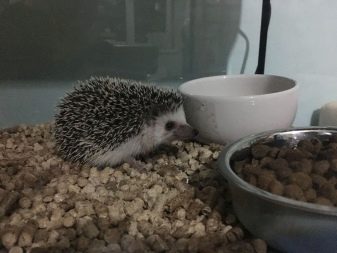

A little bit about breeding
The breeding of African hedgehogs is usually done by professionals, since this is a very responsible step for those who do not yet have experience. Decorative hedgehogs are considered mature at 6 weeksIt is very important to know that related breeding should be avoided for at least three generations, otherwise the hedgehogs may be born sick.
Very young males are not recommended to be mated with adult females, as the hedgehogs may begin to bite due to the inexperience of their gentlemen.
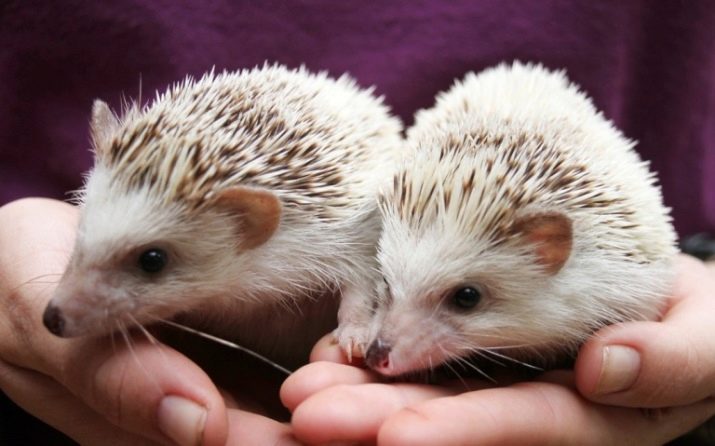
Usually knitting takes about a week, longer to keep a couple together is undesirable. Male hedgehogs can be knitted every two weeks, but females - no more than twice a year.
Pregnancy in females lasts about 36 days, during pregnancy, the hedgehog may require more food, and it also becomes slower. In the first days after giving birth, the female with the babies should be placed in a separate cage, it is best not to approach the hedgehogs. If the hedgehog learns someone else's smell, it can leave the kids. The mother feeds the first 14 days of the babies, and after 2 months they become completely independent.


See the following video for more details on breeding and caring for African hedgehogs.










